Our Founders tyres have clocked up 30,000km on varied road conditions. Let’s take a look at how they’re holding up.
These tyres are 305/70R19.5 with an aggressive mud-terrain pattern.
They’re designed for emergency vehicles in the USA… small fire trucks, first responder vehicles, and so on. Emergency departments fit out vehicles like Rams and Ford F trucks with these tyres.
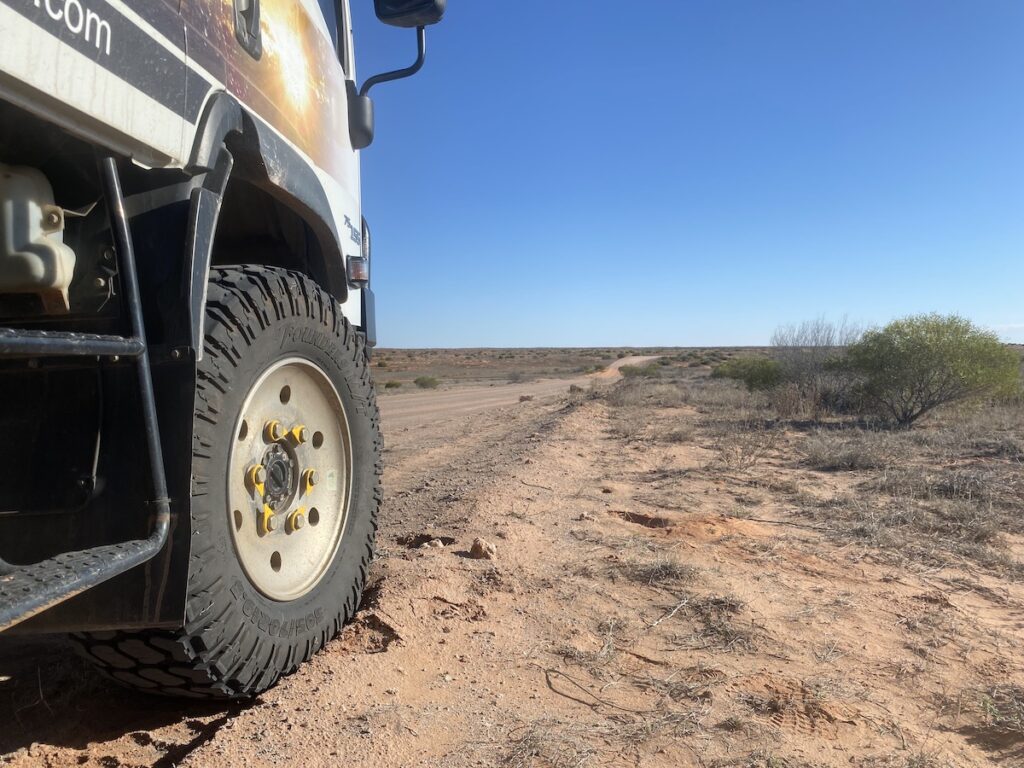
So Founders tyres are designed to cover any terrain, from snow to wildfires. Longevity isn’t a big priority, whereas reliability certainly is. And that’s what we’re finding.
And Then There Were Five…
Up until now, we’ve been happily rotating all six tyres (2 spares). But right on the 30,000km mark, I managed to kill one tyre.
Let’s be clear here. This is 100% my own stupid fault. What happened?
Since ATW fitted the tyres, one tyre has had a very slow leak. It would lose around 5psi over a couple of weeks. I hadn’t really worried too much about it or given it much thought.
This tyre happened to be on the rear right.
I love the dual valve stem setup with the 19.5” rims. But one thing bugs me about the 90° valve stems. If they’re even slightly twisted to one side, it’s really difficult to attach a tyre gauge or air chuck.
The right rear one was off-centre and I’d been meaning to straighten it. I was letting the tyres down, in preparation for several hundred kilometres of dirt road driving. So I twisted the valve stem slightly, as I’d done with others from time to time.
Off we went, driving south from Eulo into Currawinya National Park in QLD. The road was pretty rough with lots of rocks, mounded up between the wheel tracks.
We pulled up at Currawinya woolshed and there it was… a flat tyre on the right rear.
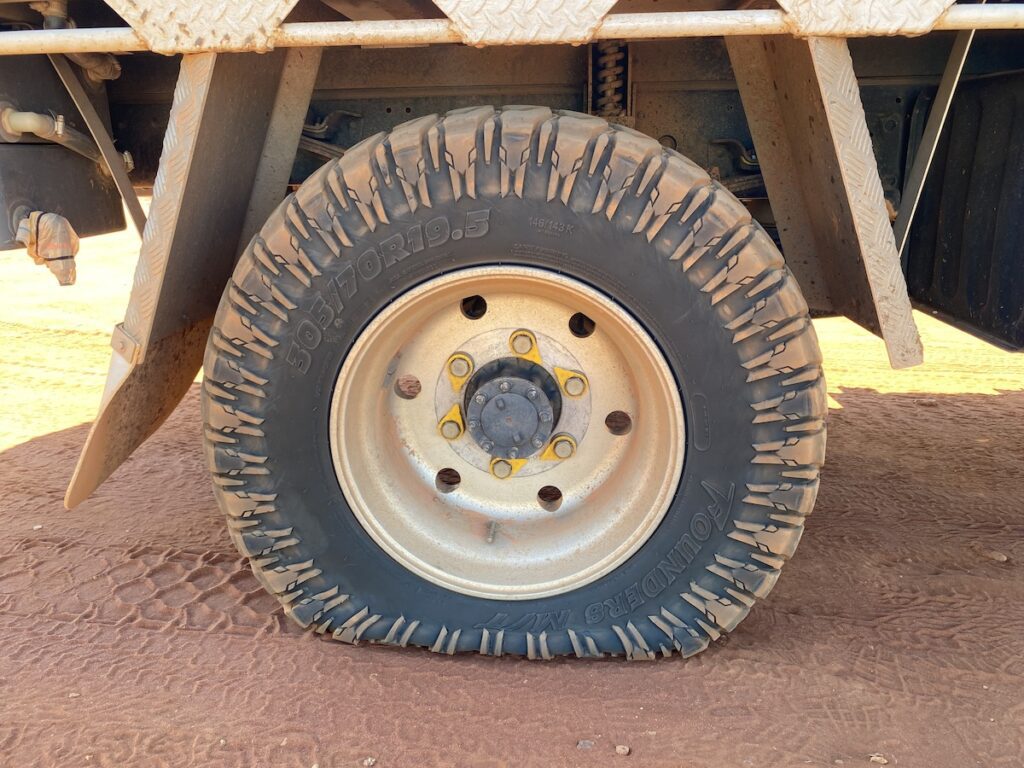
I actually did a double-take because we hadn’t had a flat tyre for so long.
In fact, the last time we had a flat tyre was due to our inexperience. We drove right up to a ruined homestead on the Strzelecki Track, way back in 2007. A whole lot of rusty wire ended up inside the tyre, shredding it from the inside out.
I suppose 16 years, hundreds of thousands of kilometres off-road, and zero flat tyres is a pretty good effort. But getting a flat is never much fun.
We stopped just in time. The tyre’s buggered… the side lugs are starting to come away from the sidewall. But at least we didn’t shred the tyre and destroy the rim.
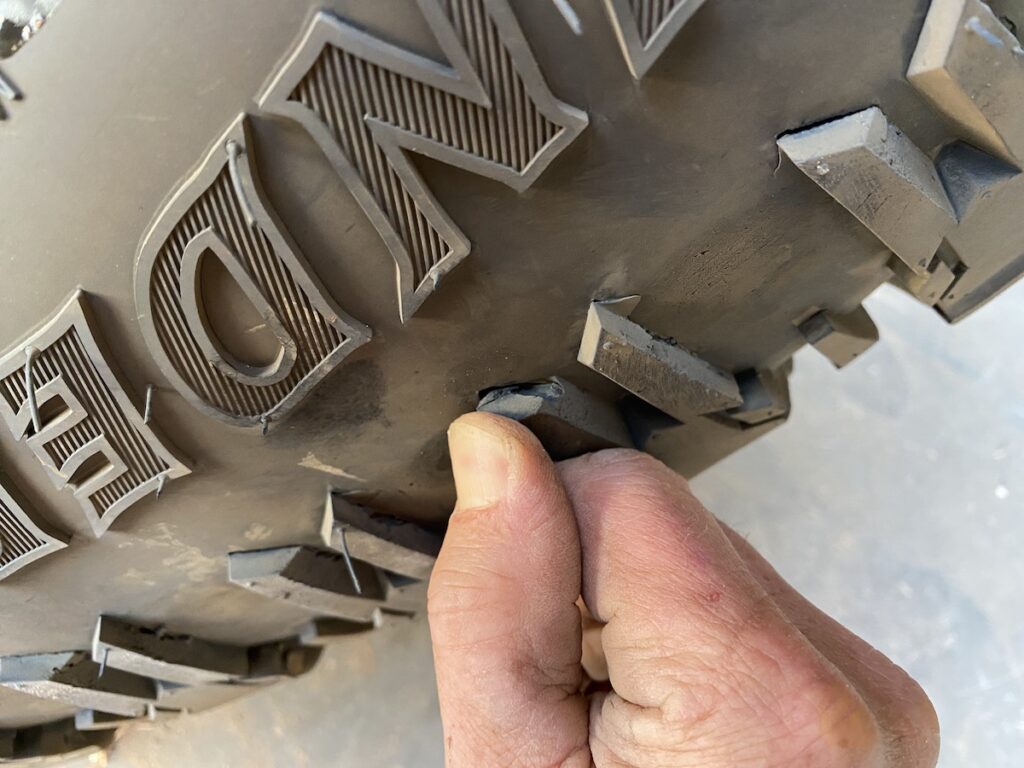
We’ve relegated the tyre to last-resort emergency use only. We’ll hold onto it until we get a new set of tyres. It could save our skin if we’re desperate.
So what happened?
Well, it was no surprise to find a leak under the rubber seal of the 90° valve stem. I’m guessing it had a tiny leak, which would explain the slow leak the tyre’s had.
But then I twisted the stem slightly and made a tiny leak a whole lot worse. Like I said, I’m 100% to blame.
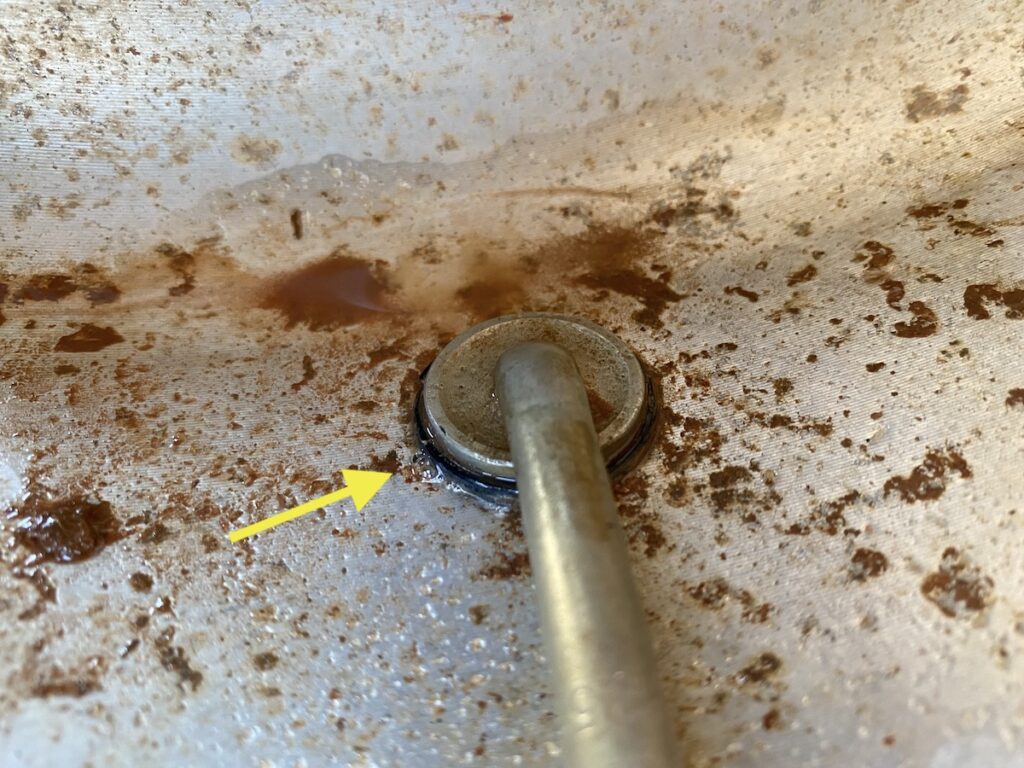
On the positive side, I was relieved a rock or stick hadn’t pierced the tyre. Founders tyres are really tough. You need to make a real effort to puncture them.
Now we’re down to five tyres, I’ll need to change the rotation sequence at 40,000km. Maybe I’ll only rotate four and keep the most worn one as the spare. I haven’t decided yet.
Overall Impressions
As we said in our 20,000km review of the Founders tyres, they’re a compromise between tyre life, durability, and ride quality.
They continue to give a softer ride than the previous Toyo tyres. The improved ride combined with their durability is a combination we’re more than happy with.
In the 30,000km since new, the tyres have spent nearly half the distance running off-road. This means reduced tyre pressures, which in turn means the sidewalls flex more and produce more heat.
Heat kills tyres, yet we haven’t had any issues. In summary, we’re super-happy with the tyres.
Now we’re down to five usable tyres, we probably won’t get much over 45,000km from a set of five. But given we were only getting around 55,000km from a set of Toyos, we’ll be happy with that.
Any Wear Issues?
Short answer – no. The steer tyres continue to wear evenly across the face. And the rears continue doing what they’ve done since the truck was new… wearing more on the outside edges than the centre.
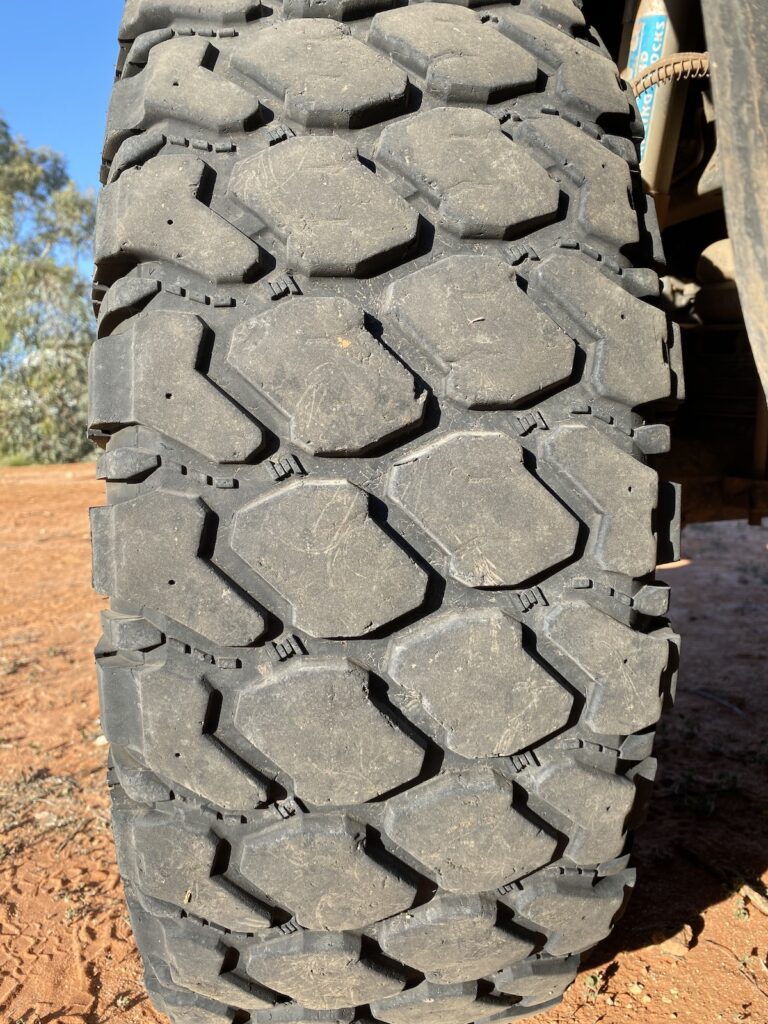
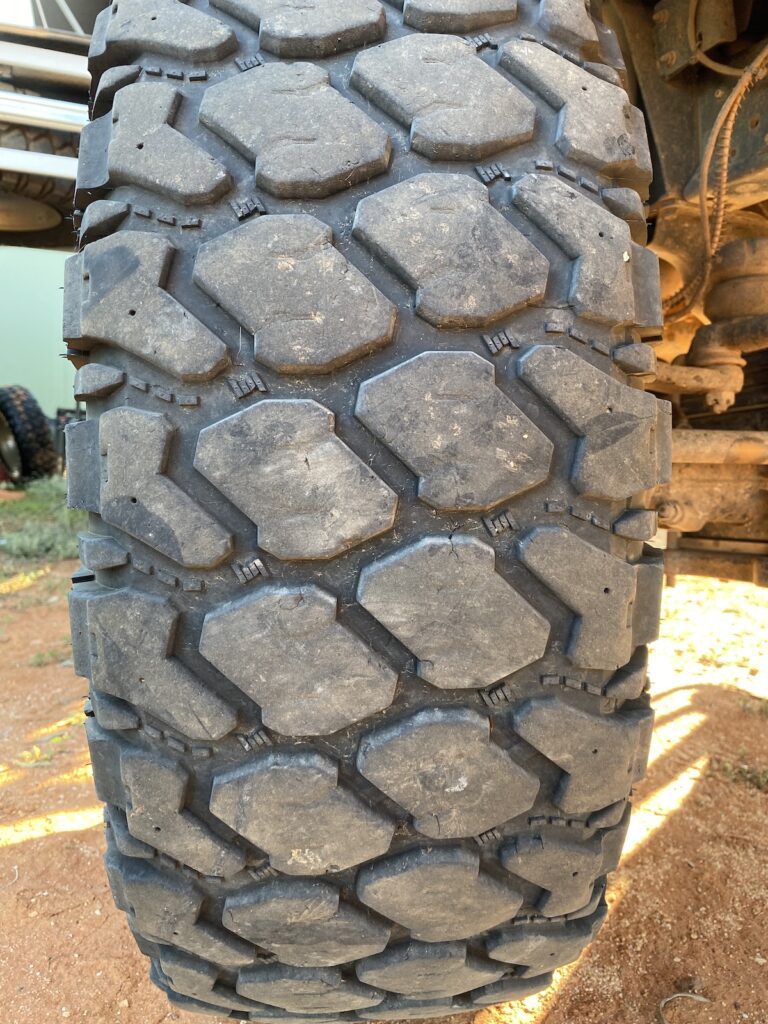
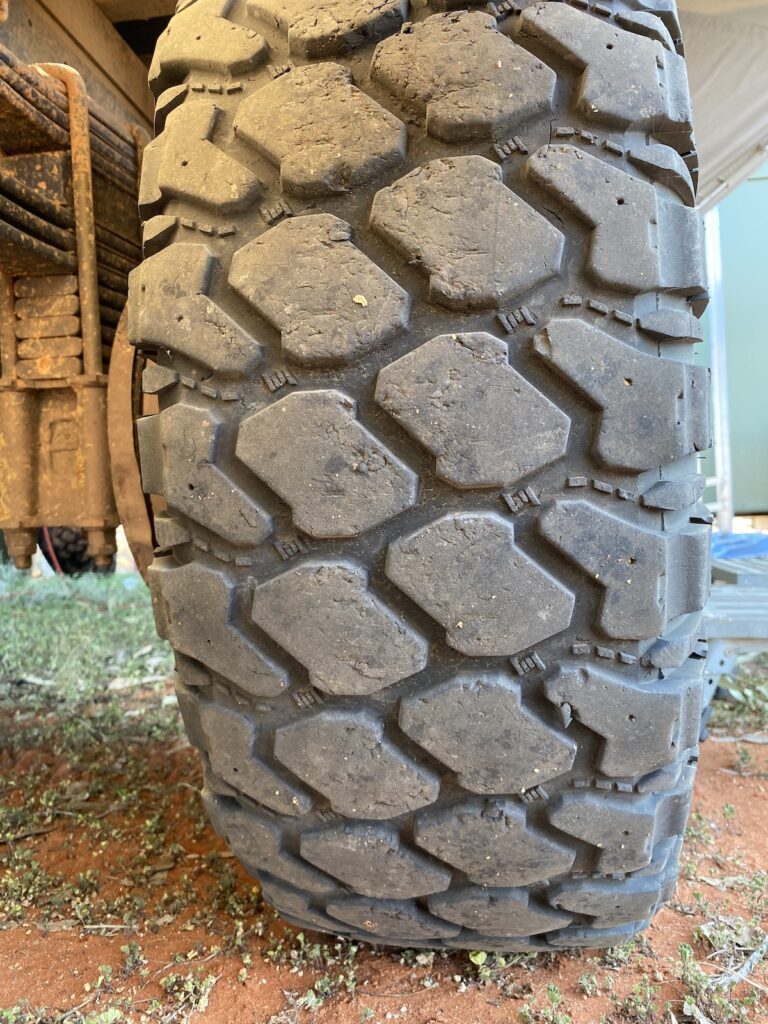
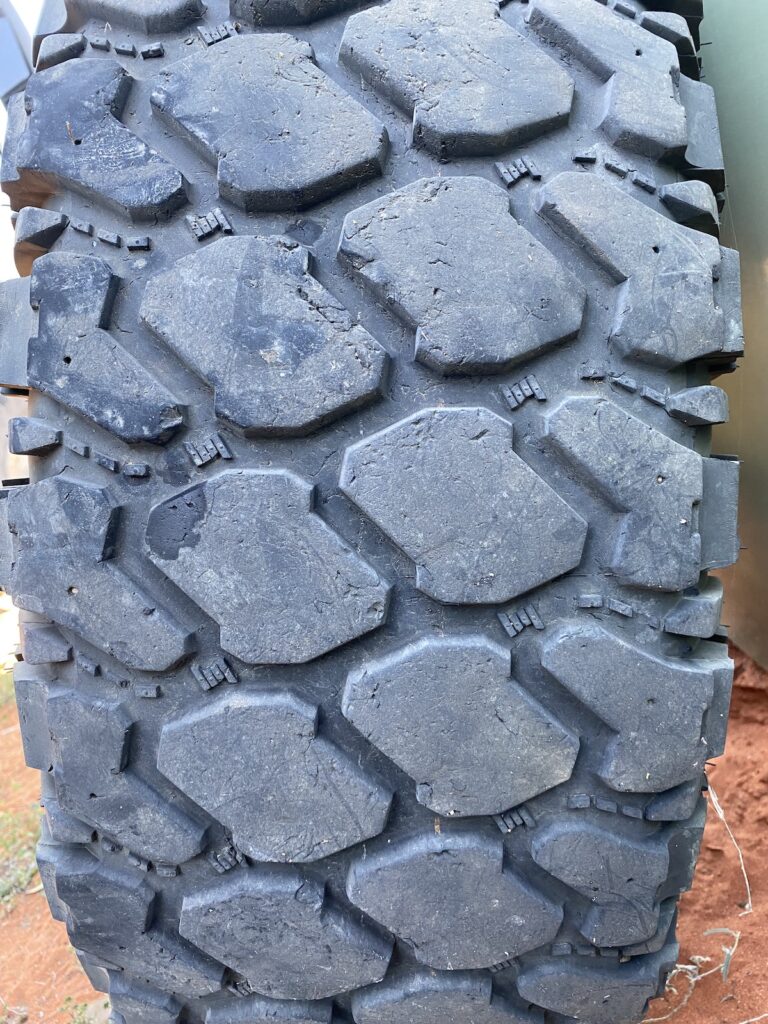
The rear wear pattern isn’t unique to the Founders tyres. Toyo tyres did the same. I tried increasing tyre pressures but it made no difference. It seems to be a rear camber issue from new.
Having said this, the uneven wear isn’t drastic. It’s more a case of having to replace tyres earlier than we should have to. The outer edges reach their minimum tread depth way before the centre and inner edges.
Yep, it’s slightly annoying. But we’ve learned to accept it as normal.
Tyre rotation’s critical. If you let the rear tyres go much past 10,000km before rotating, the outer edges will wear away quickly.
The rear tyres show quite a few nicks and cuts this time. But it’s all surface damage. Before these photos we had done at least a couple of thousand kilometres on unsealed roads. Much of it was rocky gibber plains.
So the surface damage on the rear tyres isn’t surprising.
Another issue we’ve heard about from other owners of Founders tyres is cracking. We haven’t seen anything on our tyres to be alarmed about.
Yes, there’s a crack or two in the tread faces. But they’re nothing to worry about. We run at reasonably high weights over the rear, run across a lot of bad roads, and travel in desert heat. So I would have expected to see something by now if it was an inherent issue.
What Tyre Pressures Are You Running?
We’re running:
- On tar – Front 75psi, Rear 90psi (maximum speed 100km/h).
- On dirt – Front 40psi, Rear 55psi (maximum speed 80km/h).
This is at 3.8T on the rear axle and 2.8T on the front axle.
We’ve been running rear tyres pressures 5psi higher to see if it helps with tyre wear (see above). After 20,000km at 90psi, I’m going to say the wear is a little more even. However, it’s marginal.
In the last 10,000km, we dropped the front pressure by 5psi off-road. 40psi gives a definite ride improvement without a noticeable increase in heat.
Note: Tyre pressures are totally dependent on axle weight. What works for us may not work for you if you’re running different axle weights.
How Much Tread Wear In The Last 10,000km?
Tread depth is a crude way to measure tread wear. It doesn’t tell the whole story, especially when the rears wear more on the outer edges.
However, we’ll include it here (measured in the centre) in case you’re interested:
- When new, the tyres had 13.5mm tread depth.
- At 10,000km, all four were 12.5mm. (-1mm in 10,000km).
- At 20,000km, the tyres (the ones that had done 20,000km) lost about 1mm in 10,000km. Tread depth was about 11.5mm.
- At 30,000km, the 6 tyres have all been rotated through. So each tyre has actually done around 24,000km. Tread depth is 11 – 11.5mm on average.
As I said, tread depth is pretty much meaningless. To confuse things even more, I actually did the 10K rotation at 11K, the 20K rotation at 22K, and this 30K rotation at 35K.
So the tyres have done 35,000km, not 30,000km. Except… each tyre has only done around 24,000km because I’ve been rotating six tyres, not four. Confused yet?!
In summary, if you were only rotating four tyres then the wear you see here would be what you’d expect at around 25,000km.
Based on this, I’d expect a set of four to last maybe 35,000km.
Any Other Issues?
After we rotated the tyres at 20,000km, they were noisy… really noisy. They seemed to quieten down a bit after a while. Either that, or we lost what hearing we still had!
This time, the noise didn’t really change. On some paved surfaces it’s painfully loud, on others it’s not too bad.
Noisy mud tyres isn’t exactly a new thing. We expected this. Even so, it gets tiring on long drives.
The Next 10,000km
We expected tyre wear to accelerate over the last 10,000km. But they seem to be wearing consistently.
Like any light truck tyres, the key is to rotate them regularly. A minor irregular wear pattern will develop into major wear if you don’t.
Unfortunately, we threw a spanner in the works by effectively killing one of the six tyres. Until now, the tyres had actually done around 24,000 road kilometres each, even though the truck’s done 35,000km in that time. This is due to us using six tyres on a four-wheeled vehicle.
Maybe I’ll just rotate four tyres from now on. This will keep our tyre trial simple. And it will still give us an accurate measure of how long the tyres last.
We’re still impressed with these Founders tyres. Based on what we’ve experienced so far, I expect we’ll be lining up for a new set.
As you know, ATW gave us this set to trial (see below). However, we’ll be paying for the next set. And that’s the real test.
Thanks to Chris and Nick Campbell from All Terrain Warriors for their generous offer to supply this set of tyres for us to trial… and for organising fitment, despite the pressure and uncertainty of unreliable supply chains.
Note: ATW have supplied these tyres at no charge to us. However, all our reviews are open and honest – we tell it how it is.
Go here for more Reviews on our 4×4 Isuzu NPS truck.

Get your Traveller’s Guides
… and a whole lot more at our FREE RESOURCES Page!
Any questions or comments? Go to the Comments below or join us on Pinterest, Facebook or YouTube.
Any errors or omissions are mine alone.

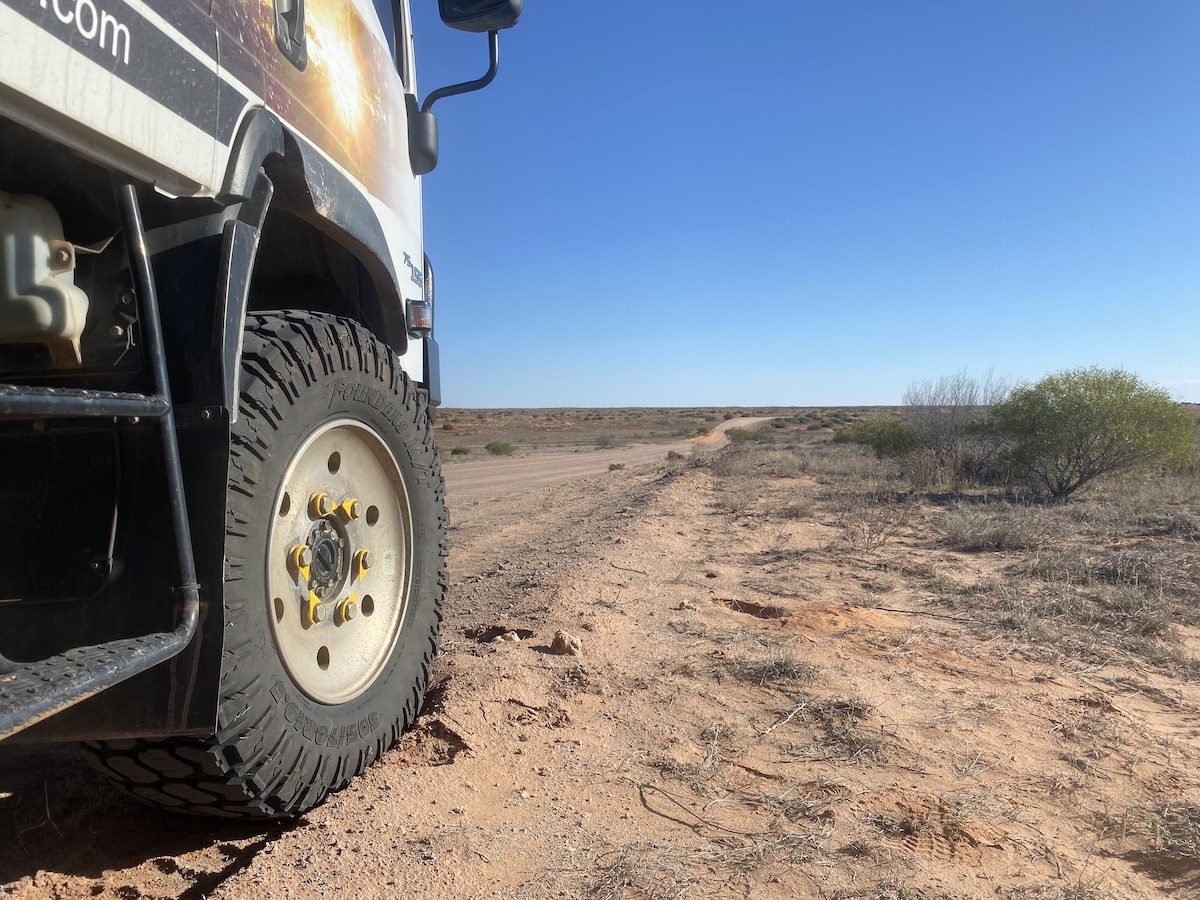
Hi I have been reading your Founders tyre reviews. We have a 7 tonne OKA with 19.5″ rims. Not a lot of tyre choices eh? Currently we have the Tyres which came with the truck – Hankook DH35 305/70/R19.5. I’m thinking about getting Founders when the time comes, but have seen ATW now stock Founders AT’s as well as the MT’s. Over tha past 6 years travelling with our Nissan Patrol & Tvan I used AT’s until I had to buy Toyo RT’s during covid when AT’s were not available. RT’s (more open tread than AT’s but less than MT’s) & to be honest saw no benefit over AT’s, & they were a bit noiser. Most of our remote travel has seen very little in the way of wet muddy going, more rocky/gravel/ & sandy. Not really expecting that to change. Have you thought about changing to AT’s when the time comes? I’m guessing they are likely a similar (or the same) soft compound to the MT’s, (do you know?) but I imagine they might last a bit longer, simply by virtue of having a bit more rubber in contact with the road. Cheers Cuppa
Hi. Not there’s not a lot of tyre choice for 19.5″ rims. And I agree – unless you’re planning to take on steep muddy firetrails, M/Ts aren’t needed. We’ve always had A/Ts on 4WDs then the truck and had zero dramas. We only used the Founders M/Ts because they were the only thing available. Plus at the time, ATW wanted us to trial them so they gave us a trial set.
We replaced the Founders M/T at around 35,000km. To be clear, that’s actual km the tyres did in contact with the road. They would have lasted until 40,000km but rego was due, and we were heading to SE QLD near ATW.
We replaced them with the Founders A/T, which are a slightly harder compound. The ride is slightly rougher but the A/Ts are way quieter than M/Ts. The M/Ts are super-loud when they wear, which as you know is typical of M/Ts in general. We sold the truck after running the A/Ts for 10,000km. In that time, we were super-happy with them.
Based on our experience with the Founders M/T and then the A/T, I wouldn’t hesitate to recommend them. Hope this helps. Cheers, Andrew